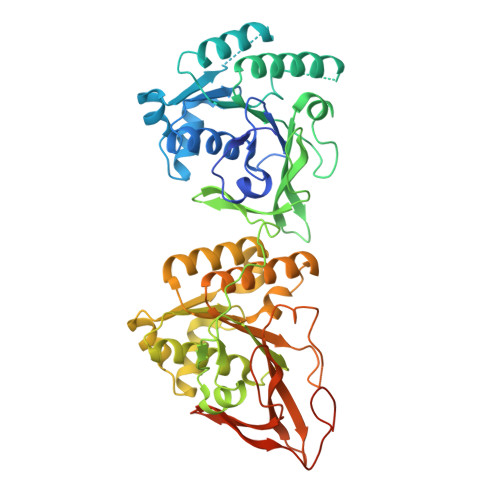Regulation mechanisms of the dual ATPase in KaiC.
Furuike, Y., Mukaiyama, A., Koda, S.I., Simon, D., Ouyang, D., Ito-Miwa, K., Saito, S., Yamashita, E., Nishiwaki-Ohkawa, T., Terauchi, K., Kondo, T., Akiyama, S.(2022) Proc Natl Acad Sci U S A 119: e2119627119-e2119627119
- PubMed: 35507871
- DOI: https://doi.org/10.1073/pnas.2119627119
- Primary Citation of Related Structures:
7DY1, 7DYE - PubMed Abstract:
KaiC is a dual adenosine triphosphatase (ATPase), with one active site in its N-terminal domain and another in its C-terminal domain, that drives the circadian clock system of cyanobacteria through sophisticated coordination of the two sites. To elucidate the coordination mechanism, we studied the contribution of the dual-ATPase activities in the ring-shaped KaiC hexamer and these structural bases for activation and inactivation. At the N-terminal active site, a lytic water molecule is sequestered between the N-terminal domains, and its reactivity to adenosine triphosphate (ATP) is controlled by the quaternary structure of the N-terminal ring. The C-terminal ATPase activity is regulated mostly by water-incorporating voids between the C-terminal domains, and the size of these voids is sensitive to phosphoryl modification of S431. The up-regulatory effect on the N-terminal ATPase activity inversely correlates with the affinity of KaiC for KaiB, a clock protein constitutes the circadian oscillator together with KaiC and KaiA, and the complete dissociation of KaiB from KaiC requires KaiA-assisted activation of the dual ATPase. Delicate interactions between the N-terminal and C-terminal rings make it possible for the components of the dual ATPase to work together, thereby driving the assembly and disassembly cycle of KaiA and KaiB.
Organizational Affiliation:
Research Center of Integrative Molecular Systems, Institute for Molecular Science, National Institutes of Natural Sciences, Okazaki 444-8585, Japan.
















